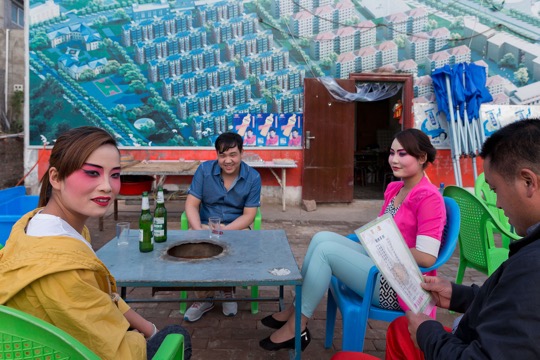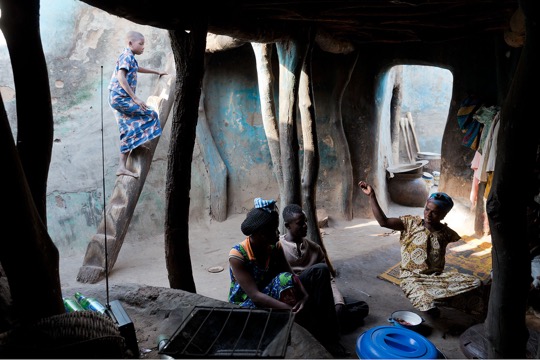Designer Q&A – Iwan Baan

Design Anthology spoke with architectural photographer Iwan Baan during Business of Design Week 2015. Baan is known for his evocative images that represent architectural forms in the context of their human environments. Coupled with minimal post processing, his acclaimed photography is sometimes gritty — but always personal. All images courtesy of Iwan Baan.
Design Anthology: Before becoming known for your architectural photography, you worked on documentaries. What sort of documentaries?
Iwan Baan: They were always sort of people stories but mainly for magazines and newspapers.
For example, when I was finishing art school, I did one on the Grameen Bank in Bangladesh —the microcredit bank— and showing sort of what people made with these microcredits around the country. I also did some books. I worked for a long time with a publisher in New York. But this was also a time when I’d just come out of art school without a really strong focus yet and was trying to find still what I wanted to tell the world.
Your background was in media but there was a turning point, you say, when you met Rem Koolhaas and you became more turned on to architectural photography. Was there something specific about architecture that spoke to you, or what made you change your course?
I was also at a point in my life where I was looking for something different. And I met Rem and I got totally fascinated with how that office works and what they’re looking at — it’s very much about the citizens and the larger implications and not just the buildings and larger designs. So I think that shaped me a lot and for me a sort of whole new world opened up at that time which was fascinating and I sort of fell into that whole world.
It wasn’t really a planned move.
But at the same time I get the sense, listening to you speak for example, that you know quite a bit. You know how to talk about architecture. Do you read a lot or is it intuitive for you?
I think it’s still very intuitive but then of course the last decade I’ve been surrounded by architects. But also looking back at my earlier work from before, it always focused very much on public space, on what people were doing. I never really had that focus on architecture or the connection with architecture, and it’s not that I suddenly started photographing in a different way. For me it was sort of a natural step and that architecture really is a sort of backdrop to my photographs.
Can you talk a little bit about your strategies for capturing that sense of space, place and light?
My background has always been more documentary photography, so for me it’s important to show what happens in these place — what people do there, and how the city around the project evolves. What are sort of the consequences of a building in this specific place? And not so much just the iconic image of a nice building that could be anywhere.
Is it hard to get people to act naturally?
Well, it’s about how you work. I don’t work with a crew. I mainly work with hand held, so you try to be really a fly on the wall and not let people consider you a photographer in the space, or people start acting differently. Also, just being present and being there for a couple of days. What happens is people start to not see you anymore, you’re more in the background, and that’s when things start to happen and you can really document what’s happening.
I understand in some of your earlier work when you were actually contacting the architects, you were asking to photograph not the sites but the communities?
Yes, that was how I started working with Rem. I made a proposal for a project and to document also the CCTV Headquarters construction. That was an incredible example of almost a city within a city. There were at times almost 10,000 people living in the site building and this whole makeshift village around it with Beijing changing by the minute as the building was going up. For me it was following the CCTV building, which I did for eight years or so, that was my whole introduction to architecture.
And the political implications of architecture as well.
Yeah, totally
You often spend time in the place that your photographing. Is there an instant impression that drives your work, or does it take some time to know what it is you’ll try to capture?
It’s like, in a way I like to go to a place without too much information beforehand or preconceptions. I don’t have huge briefing sessions or anything, it’s just very much like entering a place and seeing it with fresh and new eyes, whereas an architect has been working on that project for eight years or so. I think that’s very much a part of the work is seeing it through new eyes. But then also you spend time there and dig deeper and discovering more and more.
One things that strikes me about your work is the sheer spectrum of it — you work on some very high-end, high-calibre projects for starchitects and on the other extreme end of that spectrum are the informal housing estates and bringing attention to the human interest side of things. Does that come out of a personal interest?
Yes, it’s always been my interest, these other fields and I think there’s so many similarities between these two worlds. People basically trying to improve their living environment and to make something special and unique for themselves and you see that from the startchitects to.
So I think to see that whole scope and what’s happening in the world today is a big part of my work and also brings you a bit back to reality after seeing all the startstruck sort of work.
And how you can do things with total minimal means as well.
Do you think of your images as documentary or do you think of them as creating something new?
No, it’s creating something new. As a photographer you try to show also a reality which people sometimes don’t always see in the rush of their everyday life. But on the other hand, it’s sort of photographing and documenting what’s happening in that place at the moment, so I think it’s both ways.
You’ve talked about the importance of the aerial shot for capturing the entire context of a new build. Would you normally do that first?
Usually I would push that to last actually because you want to understand a bit more of the context first and you do that better from the ground. For example, observing where the sun is — the sunrise and the sunset and seeing how the light goes — what do the neighbourhoods around it look like and what’s happening around and usually in the last day or two I do the aerial shot. By then you really need to have your plan worked out since it’s from the helicopter so it’s relatively expensive so you have to know exactly what you want to do in such a short amount of time.
You don’t do a lot of post-production. Does that ever cost you commissions or cause you to fall out of favour with certain architects who, as you say, have spent often eight years or more on a project and want it shown in its best possible form?
What I do in post production is just what I would have done before in the darkroom — some colour correction or so. I think it’s more interesting to photograph than to sit behind a computer trying to fix things. Usually the reality is far more interesting than what you can imagine or do on the computer later. Usually it comes out as is and sometimes yeah, architects want things cleaned up but nowadays they know what my interest is and they accept it.
Is there a favourite place that you’ve visited?
This is always difficult because I just have so many favourite places. I just came back from Japan, and I’m there every two months or so, but still it’s always such a totally different world to step into — in terms of architecture and design and how everyone in the country tends to think about design in either one way or another. So I think Japan is always a very special place for me, but there are so many.
What do you have on the horizon?
I just spent several weeks in Japan working on a book with Lars Müller on the generations of architects in Japan. It’s so fascinating — their system of master-and-pupil and how these generations go all the way through to transfer ideas and knowledge and how these ideas really develop through the generations.













